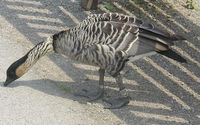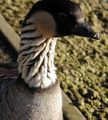Hawaiian Goose
2007 Schools Wikipedia Selection. Related subjects: Birds
| iHawaiian Goose | ||||||||||||||
|---|---|---|---|---|---|---|---|---|---|---|---|---|---|---|
 |
||||||||||||||
|
|
||||||||||||||
| Scientific classification | ||||||||||||||
|
||||||||||||||
|
|
||||||||||||||
| Branta sandvicensis ( Vigors, 1833) |
The Hawaiian Goose or Nēnē, Branta sandvicensis, is a species of goose endemic to the Hawaiian Islands. It shares a recent common ancestor with Branta canadensis, the Canada Goose. The official bird of the State of Hawai‘i, the Nēnē is exclusively found in the wild of the islands of Maui, Kaua‘i and Hawai‘i. A larger, extinct and possibly flightless species, the Nēnē-nui (Branta hylobadistes) was present in prehistoric times on Maui; related, but hitherto undescribed forms also occurred on Kaua‘i and O‘ahu, and there was a gigantic, flightless relative on the island of Hawai‘i.
The Nēnē gets its Hawaiian name from its soft call.
The species has a black head, buff cheeks and heavily furrowed neck. Bill, legs and feet are black. The young birds are as the male but duller brown and with less demarcation between the colors of the head and neck, and striping and barring effects are much reduced. Bill, legs and feet as for the adult.
The female Hawaiian Goose is similar to the male in coloring but slightly smaller.
Its strong toes have much reduced webbing, an adaptation to the lava flows on which it breeds. It mates on land unlike most other wildfowl.
This is the world's rarest goose. Once common, hunting and introduced predators such as mongooses, pigs, and cats reduced the population to 30 birds by 1952. However, this species breeds well in captivity, and has been successfully re-introduced so in 2004 it was estimated that there were 500 birds in the wild (and good numbers in wildfowl collections).




